Lacing boots

After successfully purchasing a new pair of shoes, you should think about how to lace it up correctly.




The correct lacing method will not only create additional comfort for your feet, but will also extend the life of your shoes.
So, in order to understand this matter, we bring to your attention some of the most interesting lacing methods.
Types and fashionable ways
Classic lacing



There are a huge number of ways to lace up shoes in the world. There are more than a billion of them, but among them only two are considered traditional.
- Method 1
To lace up with this method, you will need regular laces that match the style of your shoe. Pull both sides of the lace through a pair of holes located at the bottom and pull them out. We stretch the pieces of the lace from the inside out through the next two holes, crossing them. In this way, we lace up to the end. The advantages of this method are ease and convenience. It is also worth noting that the lacing tightens the boot, not the ankle, for added comfort.
- Method 2
It differs from the previous method only in that the lace is crossed alternately above and below the holes. The lace is pulled from top to bottom through a pair of holes from the bottom, its parts intersect and stretch through the next two holes. After re-crossing, the parts are passed through the next holes from the outside to the inside.We lace up the shoes completely. In addition to the speed and ease of this method, decorativeness will be an advantage, as well as the fact that this lacing technology helps to reduce wear on the laces.






For an odd number of pairs of holes, start lacing from the inside so that the laces will come out.
Straight lacing


For those who do not like the classic crisscross lacing methods, we offer straight lacing technologies. These methods differ externally and in technology from traditional ones, while they have their own advantages.
- Method 1
This method is considered traditional European. Pull the lace through the pair of bottom holes from outside to inside. Pull the left side of the lace through the hole diagonally from the inside out, passing one. Pull the right side of the lace through the next hole diagonally from the inside out. Pass the laces through directly opposite holes from the outside to the inside. Lacing one and the other part of the lace in turn to the top of the shoe.
This is one way to lace up your shoes quickly and neatly. And the zigzag pattern of the way will provide reliable and strong lacing
- Method 2
With this option, you can hide the untidy back side of the lacing and provides that the bow will not be visible.
Pull the lace through the bottom holes from outside to inside. Lead the right side of the lace from the inside to the outside with a hole above the one through which you passed it. Pass this end of the lace through the opposite hole from the outside to the inside. Lead the left lace from the inside to the outside with the hole above, passing the one into which the right end is threaded. We pass the left part through the directly opposite hole from the outside to the inside, and bring the right part to the hole higher than we brought out the left one. Thus, we lace up to the end of the shoe, tie the laces and remove the bow inside the shoe.
This lacing has a cleaner look than the previous one, but the lacing technology is a little more complicated. Most of all, this technology is intended for shoes with an even number of pairs of holes. However, with an odd number of pairs, you can skip the bottom or top pair.






Lacing winter boots
For lacing winter shoes, you need a simple, but interesting, quick and neat way of lacing that will securely fix your foot in the shoe and will not create discomfort.
Pull the left side through the hole from the inside to the outside, and the right side from the outside to the inside. Pull the left side through the hole above the right side from the outside to the inside, and the right side into the hole above the left from the inside out. Thus, through the holes on the right, the ends of the lace pass only from the outside to the inside, and into the holes on the left - only from the inside out.
We advise you to lace up your shoes in a mirror image, it will look extraordinary and very interesting.
This lacing method is also perfect for high-toed shoes. It will reduce friction, allowing you to tighten and loosen the lacing effortlessly.


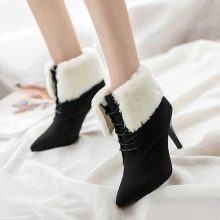



Lacing with loops


- Method 1
An interesting and unusual method of lacing, which, despite its ease of implementation, has some disadvantages. The laces do not intersect, but intertwine with each other in the middle, because of which they can move out from the middle, and also due to friction, the wear of the laces increases.
Try this method in two colors.
Pull the lace through the bottom holes from the inside out. Cross the right and left ends together, pull them into the holes above those from which they came out from the outside to the inside. Thus, you make two loops from the ends of the lace, which interlock in the middle.
- Method 2
This is a very beautiful lacing method, which differs from the previous one in that the ends of the lace are twisted twice and passed not into the hole above, but diagonally.
Pull the lace through the bottom holes from the inside out. Cross the right and left ends together twice.Pull the right end of the lace into the hole above the left, and the left end over the right, from the inside out. Continue to the top of the shoe.
This lace is very tight and will be difficult to loosen. Also, be careful not to shift the center.






Laces without a bow



Most of us dislike bows that form after tying our shoelaces. Therefore, we have found several ways to lace up shoes without a bow. One of them was described in straight lacing by the second method.
- Method 1
This method requires two pairs of laces of different colors. With one lace, you perform the second method of straight lacing, and the second lace is passed through the resulting fabric. Since the straight lacing technique has been described, let's look at how to work with the second lace. So, after you've finished the straight lacing, adjust it to fit your leg, tie the laces and hide the bow. Take the second lace, tie one end about the lower straight line of the previous lacing and hide the end. Then pull the remaining end through the "threads" alternately under and over them in a checkerboard pattern. Thus, you will be able to "weave" the fabric from laces. You can hide the second end of the lace in a way similar to the one in which we hid the first end.
We ended up with a beautiful and loose lacing, which we spent time on only once.
- Method 2
We begin to lace up from above. Tie a knot at one end of the lace. We bring the second end of the lace from any upper hole from the inside to the outside and stretch it to the opposite in a straight line from the outside to the inside. We draw from the inside to the outside of the hole diagonally and extend to the opposite in a straight line from the outside to the inside. We continue to lace up to the end in this way. The rest of the lace can be pulled up through the lacing, or you can tie a knot and trim.
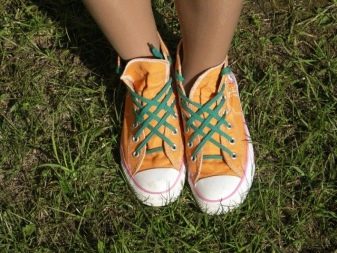

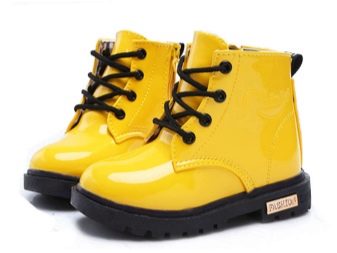



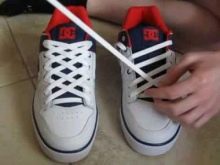
Fast lacing


Classic, straight, winter shoe lacing and loop lacing, and some of the bowless lacing techniques described above are some of the quickest ways to lace up your shoes. But the fast lacing methods don't end there. Let's give one more example as an example.
Pass the lace through the bottom holes from the outside to the inside, and pull the left end of the lace into the uppermost hole diagonally from the inside to the outside. The right end of the lace will be working. We take it out into the hole above the one into which the left one entered from the inside out. Next, we pass the right end into the opposite hole in a straight line from the outside to the inside. In this way, we lace up to the top.
Internal hidden lacing
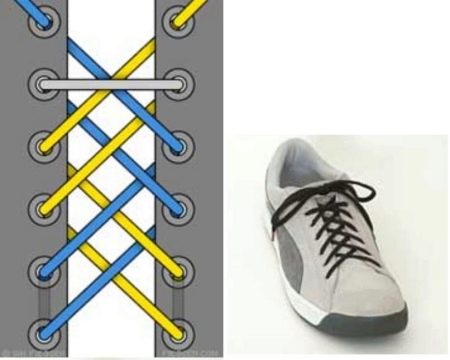
Not everyone likes lacing, which shows the inside of the lacing. We have selected the inner hidden lacing method for you.
Pass the lace through the bottom holes from the outside to the inside, and bring the left end of the lace into the upper left hole from the inside to the outside. Since the left end of the lace is not used, it should be shorter than the right. Bring the right end of the lace with a hole above the one into which it entered, from the inside out. Pass it through the opposite hole from the outside to the inside. In this way, lace up to the end.
The second method of straight lacing can also be referred to as internal hidden lacing.




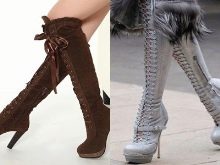

Original lacing options
Lacing for woodland or cycling

It looks unusual, but the location of the bow on the sides will ensure the safety of cycling or walking in the forest.
Pass the lace through the bottom holes from the inside to the outside. Pull out the right side of the lace and pull it through the hole above from outside to inside. Then take it out from the opposite hole from the inside out. Pull the left side of the lace through the hole, passing the one from which you just brought the right side out, from outside to inside. Pull the left side of the lace out of the hole just opposite where you inserted it. In this way, continue to lace up to the end.






Lacing "World Wide Web"

We start lacing from the second pair of holes from the bottom.To do this, we draw the lace from the inside out and stretch the ends into the holes below along the outside. We cross both parts of the lace and bring them out into the next upper holes from the inside out. Go back below and pry on the lace strip we got before. In this way, we repeat to the end, only we don’t pry it on for the last time, but simply display it and tie it.


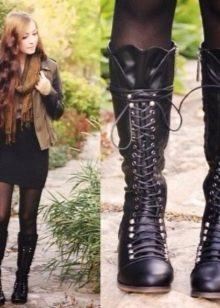
Double reverse lacing

We start lacing from the second pair of holes from the top in a way from the outside to the inside. We cross the parts of the lace and stretch them into the hole below, passing one, from the outside to the inside. So we lace up to the bottom holes, and then we stretch the ends of the lace into the holes above from the inside out and lace up to the top.
Butterfly lacing
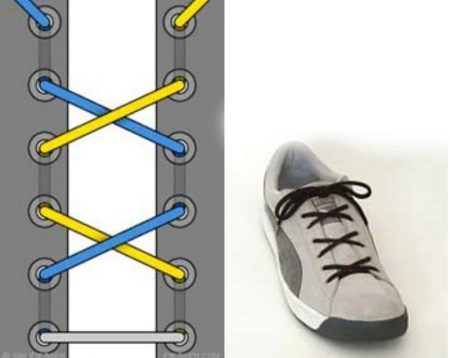
We stretch the lace into the lower holes from the outside to the inside, bring it out into the holes above from the inside to the outside. We cross and stretch into the holes. We repeat to the top. If the number of pairs of holes is even, then we replace the first action, instead of it we pull the lace from the inside out and immediately cross it.



Interesting examples
Two-tone lacing

The only drawback of this method is a knot that can get in your way. So, we tie two laces and bring the ends through different holes on one side. We lace up using the method of inner hidden lacing.



Double two-tone lacing

We lace with both laces using the first method of classic lacing, just skip the holes in order to lace in a different color.



This material presents only some of the methods and types of lacing shoes. But they will also help you look stylish and extraordinary.








